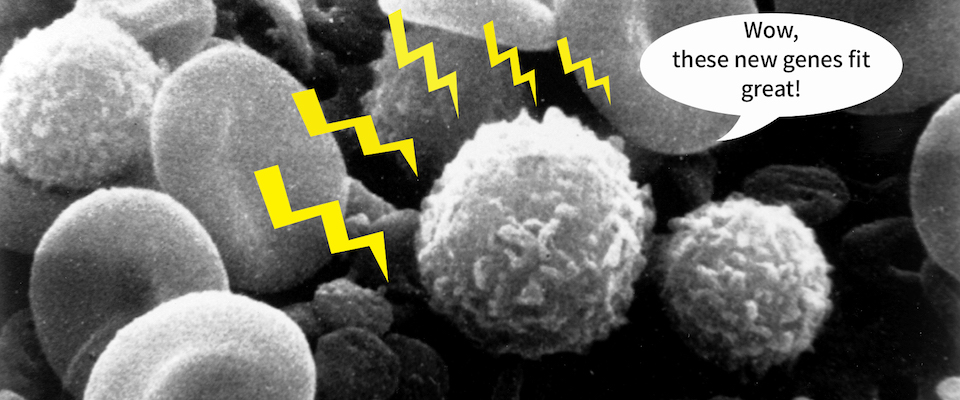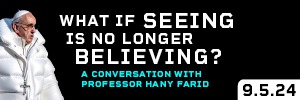Electropor-what?
Using viruses to deliver gene-editing material? That’s so 2017.
Researchers at UC San Francisco have developed a more-reliable method of reprogramming human immune cells to more quickly and accurately accept beneficial genes at the site of a CRISPR-engineered splice. The paper was published this month in Nature.
It took a whole lot of microscopic tinkering to find the right combo of gene-splicing CRISPR, the desired DNA, and quantity of “T cells.” Exposing this concoction to just the right electrical field makes the immune cells more permeable, via “electroporation,” which allows for the precise insertion of new genes.
So far researchers have tested this technique on a handful of T cells from children with a rare autoimmune disease. If all goes well, these cells will be returned to the children as a cure. Compared with other gene-editing methods, which used bespoked viruses to deliver the genes, electroporation can take a couple weeks instead of months. The breakthrough has opened up the field of medicine to better treatments for autoimmune problems, cancer, and some rare genetic diseases.
Niren Murthy, a Cal bioengineering professor, sees therapeutic applications in the not too distant future.
“That’s, I think, the really interesting thing,” Murthy said. “This is something that can translate really quickly”—from scientific concept to patient treatment.
T-$60
The milestone was more eye-catching than the actual cut. Last week, for the first time in nearly 20 years, the University of California Regents voted to decrease tuition—by $60.
It’s a paltry amount compared to the now-$12,570 base tuition and fees. But UC students were facing the possibility of a tuition hike for the coming year until state lawmakers and Gov. Jerry Brown upped the university system’s funding by nearly $347 million for 2018–19.
The 0.5-percent tuition cut itself, however, was due to the removal of a surcharge UC levied to cover the costs of litigating two lawsuits over, ironically, fee hikes. Since 2012–13, total undergraduate student charges have ticked up only minimally, and the last decrease California-resident undergrads saw was a 2.6-percent drop for the 2001–02 school year.
With two-thirds of the $347 million windfall only a one-time allocation, it remains to be seen whether decreases could become the norm.
Back to the Carving Board
The California Supreme Court hit the brakes last week on the latest attempt to triple the number of Californias. The court unanimously voted to remove from the November ballot an initiative that would carve the Golden State into three: Northern California, Southern California, and (just) California.
The justices questioned Proposition 9’s validity, arguing that “the potential harm” in keeping it on the ballot exceeded the potential harm of delaying it to a later election. It was the second million-dollar-plus attempt by Silicon Valley venture capitalist Tim Draper to ask voters to break up the country’s largest state.
“What’s rare is for the court to take an initiative off the ballot,” Ted Lempert, a political science lecturer at Cal, told the Daily Californian. “It makes sense….This initiative was so dramatic. It would not have just changed the Constitution, but also eliminated it.”
Should it have remained on the ballot, passed, and received the green light from Congress, the initiative would have raised questions about the fate of statewide university systems. Take, for instance, the question of in-state and out-of-state tuition. For the past two years, Cal has been working to boost the enrollment of California residents. For the 2018-19 school year, according to newly released numbers, the university exceeded its goal.
What would these demographics look like in a partitioned California? We may never know.
Ringing in a Centenary
On July 18, carillonists around the world celebrated what would have been Nelson Mandela’s 100th birthday. From high up in the Campanile, Leslie Chan, a student of Carillonist Jeff Davis, played a Berkeley tribute: three South African songs, including the national anthem.
Mandela’s history with Berkeley began soon after his release from prison in 1990. That year, the former South African president and anti-apartheid revolutionary toured the United States, making his last stop before a crowd of 58,000 in the Oakland Coliseum.
Starting in December of 1984, Berkeley students began routine sit-ins and protests to pressure university officials to pull their investments from companies doing business with the South African government. Their efforts paid off in July 1986 with the Regents’ $3.1 billion divestment.
In his Oakland speech, Mandela said his U.S. tour had left him feeling recharged and half his 71 years.
“It is you, the people of Oakland, the people of the Bay Area,” he said, “who have given me and my delegation strength and hope to go back and continue the struggle.”
Oakland on the Big Screen
In case you haven’t been to the theaters or seen the posters around town, Berkeley’s neighbor to the south has been in the cinematic spotlight with several new films.
Oakland-born director Ryan Coogler’s hugely successful Black Panther is set partly in the city. And Sorry to Bother You takes place in an alternate, present-day Oakland, the hometown of writer and director Boots Riley.
A third release has captured the attention of East Bay locals. Daveed Diggs and Rafael Casal, who first met at Berkeley High School, wrote and starred in Blindspotting, a new film grounded in spoken-word lyricism and set in a quickly gentrifying Oakland.
Of course, it’s no great surprise that the on-the-ground changes witnessed by both Diggs and Casal’s characters and local residents represent real changes happening in the Bay Area.
At Berkeley, Professor Karen Chapple, Dr. Miriam Zuk, and their team of researchers quantified this phenomenon in the Urban Displacement Project. They found that, in 2015, virtually all of Oakland was experiencing ongoing gentrification or displacement of low-income households. Berkeley, they found, looks much the same.



















